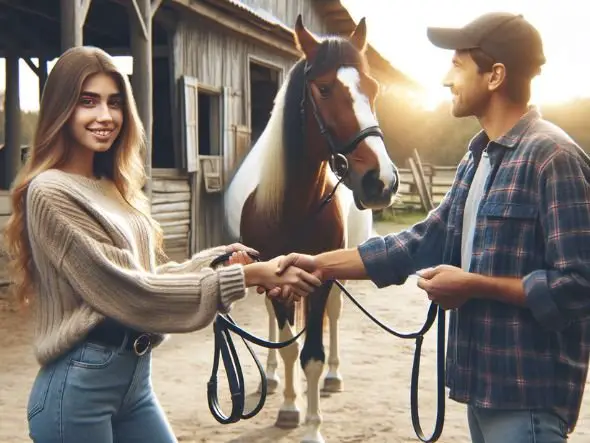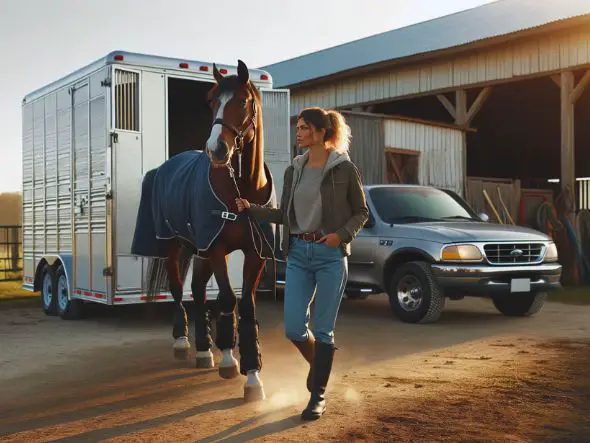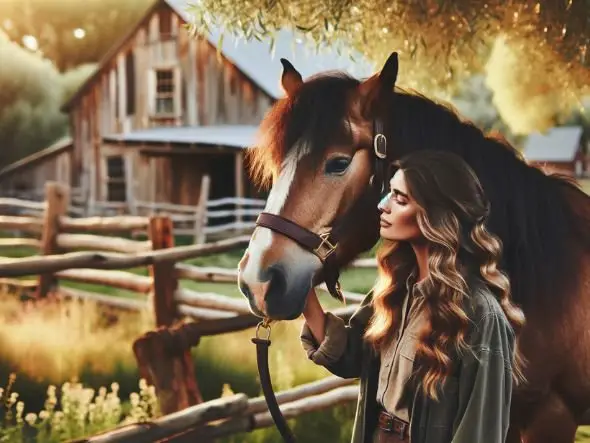Buying your first horse is both exhilarating and daunting. As you step into the journey of equine ownership, it’s so important to navigate this path with knowledge and a plan.
Alongside guiding you on what you need to do when buying your first horse, you’ll find practical tips sprinkled throughout to help make it a smooth ride into horse ownership.
From aligning your riding goals with the right horse, to understanding the particulars of horse care and management, this horse buying guide has covered all the basics.
For those seeking even deeper insights and more advice, keep an eye out for my FREE upcoming guide, “The Ultimate Checklist for First-Time Horse Buyers” eBook/PDF. I am currently crafting this resource to be full of additional insights and practical tips, aiming to help you make a well-informed and confident decision.
Now let’s start this exciting journey together, guiding you towards finding not just a horse, but a true horsey friend.
Disclosure: I am trying out using AI images and used in this post. Just wanted you to know.
1. Clarifying Your Riding Goals and Expectations

The most important thing to do first is to anchor your expectations and align them with your riding aspirations. This section helps you chart a course by focusing on your discipline, riding frequency, and specific equestrian goals.
It is especially crucial for a beginner horse rider, as it helps in setting realistic expectations and aligning them with your current riding abilities
Identifying Your Discipline and Riding Style
In my own journey with horses, one enlightening moment was while reading a book on retraining off-the-track Thoroughbreds. It detailed what to look for in Thoroughbreds suited for dressage, eventing, and hunters, and it was like a lightbulb moment. This knowledge helped me recognize the commonalities in horse types across disciplines like saddle seat and western pleasure, deepening my understanding of ideal conformation for each.
Considering your riding experience level is crucial in this diverse equestrian world, each discipline requiring a unique set of skills and characteristics from its equine participants. It is important to understand what the ideal criteria for a horse is to do well in the riding discipline of your choice.
Whether you’re interested in show jumping basics, dressage for beginners, trail riding with horses, or other horse riding disciplines, choose a horse that aligns with your chosen style.
If you’re drawn to the precision and grace of dressage, you’ll need a horse with a different skill set than if you’re planning to soar over jumps in show jumping.
Dressage horses excel in suppleness, balance, and a calm demeanor, while showjumpers require power, agility, and a bold heart.
Endurance riding, trail riding, or Western disciplines like reining and cutting, each have their own specific requirements too.
Assessing Riding Frequency and Intensity
It’s crucial to align your riding experience level with the horse’s capabilities to ensure a suitable and enjoyable partnership.
Here’s what to consider:
- Conformation and Conformation Faults: A detailed horse conformation analysis is essential to evaluate the horse’s physical structure and its suitability for your intended riding activities. A well-balanced conformation with strong, properly aligned legs and hooves is vital for a horse that will undergo rigorous training or frequent riding. Be wary of conformation faults like weak back, straight shoulders, or poor hoof structure, as these can lead to challenges in managing more moderate riding schedules.
- Past Injuries: A horse’s medical history can give you insight into its ability to handle certain riding demands. Past injuries, even if fully healed, can sometimes re-emerge under the strain of frequent or intense riding. Understanding these risks is key to ensuring you don’t overburden the horse and compromise its well-being.
- Current Fitness Level: Just like athletes, horses have varying levels of fitness. A horse that has been regularly trained and conditioned will be more adept at handling a more intensive riding schedule compared to one that has had a more sedentary lifestyle.
- Age and Current Health Conditions: The age of a horse can greatly affect its endurance and ability to tolerate frequent riding. Younger horses, while energetic, might lack the maturity and training for intense work, whereas older horses might have limitations in endurance and recovery. Current health conditions should also be evaluated, as they can influence the horse’s performance and comfort.
Assessing these factors helps in matching a horse with your intended riding frequency and intensity, ensuring a partnership that is both enjoyable and supports the long-term health and happiness of the horse.
Specific Goals and Requirements
Every rider has unique goals, whether it’s clearing a certain jump height, achieving a dressage level, or simply enjoying safe, leisurely rides. These objectives dictate the necessity for specific conformation, temperament, and training levels in your horse.
For instance, jumping high obstacles requires a horse with strong hindquarters and a bold temperament, while advanced dressage levels demand a horse with exceptional movement and sensitivity to cues. Your goals might also extend to non-competitive aspirations like trail riding or working with therapy horses, each requiring distinct characteristics such as calmness, steadiness, and adaptability.
It’s essential to outline your goals clearly and seek a horse whose attributes align with these requirements. This ensures not only the success in your chosen equestrian activities but also enhances the safety and enjoyment for both you and your horse.
Understanding these aspects helps in creating a clear picture of the ideal horse for you that not only suits your current skills and aspirations but also grows with you as you evolve in your equestrian journey.
2. Evaluating Horse Attributes in Detail

Performing a thorough horse suitability assessment is critical to ensure that the horse meets your specific needs and riding goals. This section will guide you through key factors such as age, size, training, health, temperament, responsiveness, suitability, and the all-important aspects of soundness and gait smoothness.
As you can now see choosing the right horse involves more than just love at first sight!
In my experience, I’ve always set clear criteria for size and age, typically opting for horses around 16 hands or taller, aged between 4 and 11 years. I look for a build that can handle low-level eventing, prioritizing soundness and the potential for higher levels.
Although I prefer younger horses for their longevity, budget constraints have often led me to overlook the horses training levels. Once I also overlooked the size standard I held. I purchased a Thoroughbred with less bone substance than I usually prefer and he was just over 15.2 hands.
Surprisingly, he turned out to be the soundest horse I’ve ever owned, in terms of health and he progressed the furthest in training than any of my other horses.
Age
The age of a horse can significantly impact your experience as an owner. Young horses, while often more adaptable, require extensive training and patience. On the other hand, older horses may bring experience and stability, but they can also have more health issues and less energy.
Consider your own experience and the time you’re willing to invest in training when deciding on the age of your horse.
Size
Size should match your riding needs and physical capabilities.
A larger horse might be necessary for certain disciplines, but keep in mind that they can also mean higher maintenance costs and more strength required for handling. Conversely, a smaller horse could be easier to manage but may not meet the needs of larger riders or certain competitive disciplines.
Training
Evaluate the horse’s training level against your riding skills. A well-trained horse can be a joy for a beginner, offering a safer and more enjoyable learning curve.
Conversely, a horse with minimal training might present a challenge but could be a rewarding project for a more experienced rider.
Health
A horse in good health may sound like an obvious thing to want in a horse, but many people miss spotting health issues until it is too late. This goes beyond the absence of illness – it includes overall condition, such as coat health, hoof quality, and body condition. A key aspect of evaluating a horse’s health is understanding its history of horse vet care and any ongoing medical needs.
Always conduct a thorough veterinary check to uncover any underlying health issues.
Temperament
Temperament assessment is an important part of the process to find a horse that is the right fit for you. Look for a horse whose temperament suits your riding style and experience.
A calm, easy-going horse is often ideal for beginners, while a more spirited horse might suit an experienced rider seeking a challenge.
Responsiveness
A responsive horse is easier to train and handle. It should be attentive to your commands and willing to learn. This trait is particularly important for competitive riding, where precision and quick reactions are essential.
Suitability
Consider how well the horse suits your intended use. This encompasses not only its physical attributes and training but also its past experiences and current comfort with your intended riding style and environment.
Assessing Soundness
Soundness refers to the absence of injury or lameness in a horse, and it’s a non-negotiable aspect of your decision. A sound horse will not only ensure rider safety but also longevity in the horse’s active life.
Gait Smoothness
Gait smoothness, while impacting rider comfort, also reflects the overall health and balance of the horse. A smooth gait generally indicates good joint health and proper conformation, which are vital for the horse’s well-being and performance.
Evaluating these attributes we just talked about in detail will lead you to a horse that more closely aligns with what you need based on your goals.
3. Thoroughly Testing and Observing Potential Horses

Selecting the right horse is a process that involves careful observation and testing. This section guides you through the crucial steps of conducting a rigorous trial, preparing for horse visits, evaluating the horse thoroughly, and observing the interaction between horse and rider.
Before I continue on I just want to share a quick lesson I learned the hard way. It involves the importance of verifying a horse’s age before purchase. I once bought a horse I believed to be 3 years old, expecting him to have a few years to fill out and grow.
However, upon checking his papers at home, I discovered he was actually 8. This experience taught me the value of thoroughly reviewing a horse’s documents, especially for Thoroughbreds, where verifying pedigree online is also an option.
Conducting a Rigorous Trial
When trying out a potential horse, it’s important to assess compatibility through various tests. Here are some tips:
- Ride in Different Settings: Ride the horse in a familiar environment as well as in new or challenging settings. This can reveal how the horse reacts to stress and unfamiliar situations.
- Test Various Gaits and Commands: Experience all the gaits of the horse – walk, trot, canter, and if applicable, gallop. Practice transitions between gaits and observe the horse’s responsiveness to your commands.
- Simulate Your Typical Riding Routine: If you plan to compete, simulate aspects of the competition. For leisure riding, try a relaxed trail. This helps in understanding how the horse performs under your typical riding conditions.
Preparing for Horse Visits
Before visiting a horse, prepare a checklist of what you need to observe and questions to ask the current owner or handler. This includes the horse’s history, temperament, health issues, and performance record.
Dress appropriately for riding and bring any personal gear you would typically use.
Conducting a Thorough Evaluation
During the visit, assess the horse’s overall health and condition. Look at its coat, hooves, and body condition. Understanding horse behavior is key.
Pay close attention to how the horse responds to your cues and its overall demeanor during your interaction. Observe its behavior in the stable and while being saddled.
Also pay attention to how it interacts with other horses and people around.
Observing Horse-Rider Interaction
Pay close attention to how the horse responds to you as a rider. Is it calm or anxious? Does it respond well to your cues? Also, observe your own comfort and ease while riding.
The horse should feel like a good fit for you, not just in terms of size and strength, but also in temperament and responsiveness.
Take note, while this guide focuses on buying, it’s important for first-time buyers to familiarize themselves with horse training basics. Even basic ground manners training can significantly affect your experience with your new horse.
Conducting these thorough tests and observations is key to making the best decision. It’s not just about finding a horse that meets your requirements on paper, but one that you connect with and feel comfortable and safe riding. Remember, this is hopefully a long-term partnership, and ensuring a good match is crucial for both your happiness and your horse’s.
4. Comprehensive Pre-Purchase Planning

Buying a horse is a significant commitment that goes beyond the initial purchase. This section focuses on the vital steps of understanding equine care, estimating costs, preparing before the purchase, and budgeting effectively.
Understanding the Care Your Horse Needs
As a first-time horse owner, understanding the full spectrum of care your horse needs is fundamental to ensuring its well-being.
You want to familiarize yourself with horse care essentials:
- covering daily feeding
- grooming
- exercise
- regular veterinary exams
- hoof care
- dental care
- and more
Regular horse health checks are essential. Part of the pre-purchase is to uncover any underlying health issues, but you will want to continue scheduling yearly health checks throughout your horse’s life. Also different horses and activities might require specialized care routines.
Part of responsible ownership is addressing horse welfare concerns, ensuring that your horse’s physical as well as emotional needs are met, like regular interaction and companionship, either from you or other horses.
Estimating Overall Costs
The cost of owning a horse extends far beyond its purchase price. Here’s a breakdown:
- Purchase Price: This can vary widely based on the horse’s breed, age, training, and pedigree.
- Basic Care: Includes feed, hay, supplements, and bedding.
- Equipment: Saddles, bridles, grooming supplies, and riding gear.
- Healthcare: Routine veterinary care, vaccinations, deworming, and emergency medical expenses.
- Hoof Care: Regular farrier visits for trimming and shoeing.
- Insurance: Many owners opt for equine insurance to cover unexpected health issues or accidents.
- Boarding Costs: If you don’t have your own stable, boarding your horse at a facility is an additional expense.
- Unforeseen Expenses: Like any pet, horses can incur unexpected costs.
Budgeting for Your Horse
Effective budgeting is essential for responsible horse ownership. Budgeting for a horse involves not just the purchase cost but also ongoing horse maintenance costs, including feed, health care, and equipment.
Account for both upfront costs (like purchase and initial equipment) and ongoing expenses (like feed, healthcare, and boarding). Set aside funds for emergency veterinary care.
It’s advisable to create a monthly budget to keep track of expenses and ensure you’re financially prepared for the long-term commitment of horse ownership.
Preparing Before the Purchase
Ensure you have all the necessary arrangements in place before bringing your horse home:
- Housing: A safe, comfortable stable or shelter and a paddock or pasture.
- Equipment and Supplies: Grooming supplies, buckets, barrels, cleaning supplies, grain, hay and bedding,. Often for horse gear, you need to know the horses size for proper fit. It is very important to have the saddle fitted to the horse properly as well as to the rider.
- Professional Network: Establish contacts with a vet, farrier, and feed/hay supplier. Consider finding a horse trainer or instructor if you’re a novice rider.
Pre-purchase planning sets the foundation for a responsible horse ownership.
By understanding and preparing for the various aspects of horse care and costs, you’ll be much better equipped to provide the ideal and most sustainable home for your new horsey companion.
5. Making an Informed Decision

After visiting and assessing several horses, the next step is to systematically evaluate your options to make the best choice. This section provides guidance on keeping track of potential horses.
Keeping Track of Potential Horses
Documenting and comparing the horses you’ve visited is crucial in making an informed decision. Here’s how to approach it:
- Create a Comparison Chart: Develop a chart or spreadsheet where you can list each horse and its attributes side by side. Include categories like age, breed, size, training level, temperament, health, and any specific notes from your visits and trials. If you’re considering competition, evaluate the horse competition record as part of your decision-making process.
- Use a Scoring System: Assign scores to each attribute based on your priorities. For instance, if temperament is your top priority, rate each horse in this category from 1 to 10. This method helps in quantifying subjective observations and making comparisons easier.
- Take Notes and Photos: During each visit, take detailed notes and photographs. Note your first impressions, the horse’s response to you, and any standout characteristics. Photos can help you remember each horse, especially when considering multiple options.
- Consult with Professionals: Share your findings with a trusted horse trainer, veterinarian, or experienced horse owner. They can provide valuable insights and may notice things you missed.
- Reflect on Your Personal Connection: While data and scores are important, don’t overlook your personal connection with the horse. Sometimes, the best choice is the horse you feel most drawn to and comfortable with.
- Revisit Top Choices: If possible, revisit your top choices for a second look. A second visit can confirm your initial impressions or reveal new information.
By meticulously documenting and comparing potential horses, you can make the best decision possible that aligns with your needs, abilities, and expectations.
This thorough approach helps to make sure that the horse you choose is not only suitable on paper but also a good match for you in reality.
6. Finalizing Your Horse Purchase

You’re almost at the end of your journey to buying a horse. This crucial phase involves ensuring the horse’s health and well-being through a veterinary exam and understanding the steps to complete the purchase.
Importance of a Comprehensive Veterinary Exam
Before finalizing your purchase, a comprehensive veterinary exam is essential. This is known as a pre-purchase exam and typically includes:
- General Health Check: Evaluating the overall health, checking for signs of illness or distress.
- Lameness Assessment: A thorough examination to check for any signs of lameness or underlying musculoskeletal issues.
- Flexion Tests: To assess the health of the horse’s joints and tendons.
- Blood Tests: These can reveal underlying health issues not immediately apparent.
- Dental Check: Ensuring the horse has no dental issues that could affect feeding or bitting.
- Review of Vaccination and Deworming Records: To ensure the horse is up-to-date with necessary care.
This exam is crucial not only for the health and well-being of the horse but also to ensure you are purchasing a horse that can handle what you hope to do with a horse.
Completing the Purchase Process
Once you’ve decided on a horse and completed the veterinary exam, the next step is to finalize the purchase:
- Negotiating Price and Terms: Be prepared to negotiate the price based on your budget and any findings from the veterinary exam. Discuss terms of sale, including any trial period or return policy.
- Understanding Sales Agreements: A sales agreement should address equestrian legal concerns and the terms of the sale, including the price, any warranties (or lack thereof), and responsibilities of each party. Read and understand this document thoroughly before signing.
- Transferring Ownership: Ensure all necessary documents are transferred to you, including registration papers (if applicable), health records, and ownership papers.
- Payment and Receipt: Complete the payment as per the agreed terms and ensure you receive a receipt that acknowledges the transaction.
- Insurance: Consider purchasing insurance for your horse immediately upon ownership transfer.
7. Preparing for Your Horse’s Arrival

With the purchase of your horse completed, it’s time to focus on ensuring a smooth transition for its arrival. This section guides you through the process of transporting your horse, preparing its new home, and planning its daily care and routine.
Transporting Your Horse
Adhering to horse safety measures during transportation is critical to prevent injuries and stress.
- Choose the Right Transport: Many first-time horse owners may not have their own trailer. Consider asking an experienced horse-owning friend or instructor for assistance, or hire a professional horse transport service. Ensure the vehicle is well-ventilated, secure, and appropriate for your horse’s size.
- Prepare for the Journey: Alongside protective gear like leg wraps and a tail guard, ensure your horse wears a safety helmet for added protection. If the journey is long, plan for regular stops to provide water and check on your horse’s well-being.
- Professional Assistance for Loading: If you’re unable to train your horse for loading and unloading due to lack of experience or facilities, seek help from a professional or an experienced horse handler.
Preparing Their New Home
Effective stable management is key to ensuring a comfortable environment for your horse, whether at a boarding facility or your home stable:
- Boarding: If boarding, choose between co-op, rough or semi-rough board, and full board based on your budget and the level of care you wish to provide personally. Ensure the facility meets your horse’s needs in terms of space, safety, and care.
- Home Stabling: For those bringing the horse home, ensure the stable or shelter is clean, dry, and safe. The paddock or pasture should be secure and free from hazards.
- Bedding and Feed: Prepare the stall with appropriate bedding. Regardless of boarding or home care, ensure a consistent supply of quality feed and clean water.
Planning for the Horse’s Daily Care and Routine
Establish a routine that ensures your horse’s health and happiness. Mastering horse feeding basics and grooming essentials are the first steps in providing daily care, ensuring your horse is well-fed, clean, and healthy
- Feeding and Hydration: Understand the feeding schedule and dietary needs of your horse, especially if they’re being boarded. Ensure a consistent supply of clean water is always available.
- Exercise and Socialization: Plan for regular exercise, whether through riding or turnout. Social interaction is also important, so consider the social dynamics at the boarding facility or at home. A horse will need the companion ideally of another equine.
- Grooming and Health Checks: Regular grooming is essential, regardless of where your horse is housed. It’s also an opportunity for bonding and health monitoring.
- Veterinary and Farrier Care: Keep up with routine veterinary check-ups, vaccinations, and hoof care. Know the schedule for these services at your boarding facility, or arrange them independently if your horse is at home.
By carefully planning the transport, preparing their new home, and establishing a daily care routine, you’ll ensure a less stressful transition for your new horse.
Whether you’re boarding or keeping your horse at home, understanding these elements are key to a successful start to your horse owner journey.
8. Welcoming Your Horse Home

The day has arrived to welcome your horse to its new home. Whether you’re boarding or keeping the horse on your property, the initial introduction to its new environment and establishing a routine are crucial steps.
Developing horse handling skills and learning horse bonding techniques are so important in establishing trust and a strong relationship with your new horse.
Introducing Your Horse to Its New Environment
A smooth transition to new surroundings is essential for your horse’s comfort and adjustment:
- Take it Slow: Allow your horse to explore its new environment gradually. Start with the stable or stall, letting it sniff around and get comfortable.
- Introduce to Turnout Areas: Gradually introduce your horse to turnout areas or paddocks. Supervise these initial outings to ensure safety and comfort.
- Meet New Companions: If there are other horses, introduce them slowly and under controlled conditions. Watch for signs of stress or aggression.
- Familiarize with Sounds and Sights: Spend time with your horse as it gets used to the sounds, sights, and routines of the new environment. Patience is key during this adjustment period.
- Stay Calm and Positive: Your horse can pick up on your emotions. Maintain a calm and positive demeanor to help your horse settle in.
Initial Care and Establishing a Routine
Establishing a routine from the start is vital for your horse’s well-being:
- Consistent Feeding Schedule: Stick to a regular feeding schedule. If there’s a change in diet from its previous home, transition gradually to avoid digestive upset.
- Daily Grooming: Regular grooming not only keeps your horse clean but also strengthens your bond and allows you to check for any health issues.
- Regular Exercise: Ensure your horse gets adequate exercise based on its needs. This could be riding, lunging, or turnout time. But it is totally acceptable to let the horse settle in for a few days before you start training and riding.
- Monitor Health: Keep a close eye on your horse’s health during the initial days. Look for signs of stress, discomfort, or illness.
- Bonding Time: Spend quality time with your horse. This could be through grooming, gentle handling, or just being present, which helps in building trust and a strong relationship.
Welcoming your horse home and into its new life is probably the most rewarding part of the process. By focusing on a smooth introduction and establishing a care routine, you’re laying more building blocks for the groundwork to establish a happy, healthy partnership with your horse.
FAQs New First Time Buyers Have
What is the best breed of horse for beginners?
The best horse breed for beginners often depends more on individual temperament and training than breed. However, some breeds frequently recommended for their generally calm and forgiving nature include the American Quarter Horse, known for its versatility and steady temperament; the American Paint Horse, which is similar to Quarter Horses in temperament; the Morgan Horse, valued for its loyalty and gentle demeanor; and the Tennessee Walking Horse, recognized for its smooth gait and calm nature. It’s crucial to consider the individual horse’s personality and experience alongside breed characteristics.
How much does a beginner horse cost?
The cost of a beginner horse varies widely depending on breed, age, training, and location. On average, for a first-time horse suitable for a beginner, you might expect to pay anywhere from $3,500 to $10,000. However, prices can be lower for less trained or older horses, and significantly higher for those with specific desirable traits or advanced training. It’s important to remember that the purchase price is just the start; ongoing costs for care, feeding, boarding, and veterinary expenses can be substantial.
What to look for when buying your first horse?
When buying your first horse, consider the following:
Temperament: Look for a calm, patient, and forgiving horse, often described as “bombproof” or “steady”.
Health: Ensure the horse is healthy with a veterinary check-up.
Horse Breeds: When it comes to horse breeds for beginners, certain breeds are known for their suitability and temperament for novice riders. Though not most important consideration in my opinion, if everything else is aligned with needs.
Training: Choose a well-trained horse suitable for beginners.
Age: An older, more experienced horse might be better for a first-time owner.
Size: Ensure the horse’s size is appropriate for your riding skills and comfort.
Riding Goals: Match the horse to your riding style and goals.
History: Ask about the horse’s past training, health issues, and behavior.
Compatibility: Spend time with the horse to ensure a good fit.
Cost: Consider not only the purchase price but also ongoing care costs.
Always seek advice from an experienced equestrian or a professional trainer when making your decision.
How to care for a horse for beginners?
Caring for a horse as a beginner involves several key aspects:
Feeding: Provide a balanced diet including quality hay, grass, and grains as needed. Ensure constant access to clean water.
Housing: Maintain a clean, safe, and secure stable or shelter. Pasture should be fenced properly.
Health Care: Regular veterinary check-ups, vaccinations, and deworming are crucial.
Hoof Care: Schedule routine farrier visits for hoof trimming and shoeing if necessary.
Exercise: Ensure regular exercise, which can include riding, lunging, or turnout in a pasture.
Grooming: Regular grooming helps maintain skin and coat health and strengthens your bond with the horse.
Companionship: Horses are social animals, so provide social interaction with people or other horses.
Education: Continually educate yourself about horse care and seek advice from experienced horse owners or professionals.
Always prioritize your horse’s welfare and don’t hesitate to seek help when needed.
What age horse is good for a beginner?
For a beginner, a horse aged between 10 to 15 years is often ideal. Horses in this age range typically have enough training and experience to be calm, patient, and forgiving with new riders. They are more likely to have a steady temperament and be less reactive than younger horses, making them well-suited for those just starting to learn riding and horse care. The key is to find a horse with a suitable temperament and training level, regardless of its exact age.
What are common mistakes in buying a first horse?
Common mistakes when buying a first horse include:
Prioritizing appearance over temperament and suitability.
Not seeking professional advice or a pre-purchase veterinary examination.
Ignoring the horse’s training level and compatibility with the rider’s experience.
Overlooking ongoing costs and time commitment for care.
Rushing the decision without exploring multiple options.
Failing to consider the horse’s health and soundness.
Not understanding the horse’s history and behavior.
How to choose a horse for first-time owners?
For first-time horse owners:
Prioritize temperament: Look for a calm, gentle, and patient horse suitable for beginners.
Choose a well-trained horse: Opt for one that is easy to handle, groom, and ride.
Consider the horse’s health: Ensure it is sound and healthy through a pre-purchase veterinary examination.
Match experience levels: Select a horse that matches your riding skill and experience.
Seek professional advice: Get guidance from experienced horse people or trainers.
Avoid impulsive decisions: Take your time to find the right match.
What is the lifespan of a beginner-friendly horse?
The lifespan of a beginner-friendly horse, like most horses, typically ranges from 25 to 30 years. However, this can vary based on factors like breed, care, health, and environment. Some horses, with proper care and good genetics, may live into their 30s or even 40s. The key factor for beginner-friendly horses is not age but their temperament and training, which makes them suitable for inexperienced riders.
Are ponies or horses better for beginners?
Whether ponies or horses are better for beginners depends on the rider’s size and age. Ponies are often ideal for children due to their smaller size and generally calm temperament, making them easier to handle and less intimidating. For adult beginners, larger horses might be more suitable due to their ability to comfortably carry more weight. Both can have beginner-friendly temperaments, but it’s essential to assess individual personality, training level, and suitability for the rider’s skill level.
How to train a horse for beginners?
First and foremost a beginners should not be training a horse.
But training a horse the very basics involves:
Establishing basic ground manners: Teach the horse to lead, stand still, and respect personal space.
Desensitizing: Expose the horse to various stimuli gently to reduce spooking.
Basic commands: Train the horse to respond to basic cues for walk, trot, canter stop, and turn.
Consistency: Use consistent commands and rewards.
Safety: Prioritize safety for both handler and horse.
Seek professional help: If you are a beginner you should be working with a riding instructor and an experienced horse trainer should be working with your horse, especially for more complex training.
starting your journey to buying your first horse
Throughout this guide, we’ve gone through the key stages: from clarifying your riding goals and expectations, evaluating horse attributes, conducting thorough tests and observations, to the detailed pre-purchase planning.
We’ve talked about the importance of a comprehensive veterinary exam, finalizing your purchase, and preparing for your horse’s arrival.
Finally, we’ve covered how to warmly welcome your horse home and establish a daily care routine.
Each of these steps you go through in your journey to getting a horse will help you get started in the right direction.
Though horse ownership can be a roller coaster of ups and downs you can also expect rewarding experiences with your horse, filled with growth, learning, and joy.
Before making your decision, refer back to this horse buying checklist encapsulated in our guide, ensuring you’ve covered all essential aspects.
Remember, I am also in the process of creating the “Ultimate Checklist for First-Time Horse Buyers” eBook/PDF, a guide brimming with insights to support your decision-making journey. Keep this upcoming resource on your radar as it will provide much more detailed guidance in your quest for the perfect horse.
What is the biggest challenge or concern you’re facing in selecting your first horse? (Share your thoughts and experiences in the comments below – let’s support each other in this exciting journey.)
Cheers, Kacey
P.S. Did you like this article? Gallop over to:

